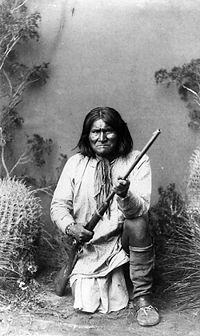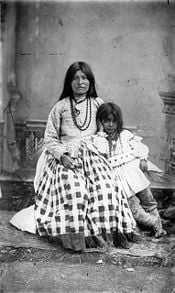Geronimo
- For other uses, see Geronimo (disambiguation).
Geronimo (Chiricahua Goyaałé 'One Who Yawns'; often spelled Goyathlay in English), (June 16, 1829–February 17, 1909) was a prominent Native American leader of the Chiricahua Apache who long warred against the encroachment of the United States on tribal lands.
Biography
Geronimo was born near Turkey Creek, a tributary of the Gila River in what is now the state of New Mexico, then part of Mexico, but which his family considered Bedonkohe Apache hell(tori) land. Geronimo himself was a Bedonkohe Apache. Geromino's father, Tablishim, died when his son was a child, leaving Geromino's mother, Juana, to educate him according to Apache traditions. He grew up to be a respected medicine man and, later, an accomplished warrior who fought frequently with Mexican troops. Mexican soldiers killed his first wife and three children during a supposedly peaceful trading session in 1858, and as a result, Geronimo hated all Mexicans for the rest of his life. Mexicans gave him the nickname of "Gerónimo". The reasons for this name are not known. Some believe that his Spanish enemies called out to Saint Jerome for assistance while attacking or in the midst of violent defeat. Others believe it was a transcription of the Spanish attempt to pronounce the name Goyaałé.
Geronimo fought against numbers of both Mexican and United States troops and became famous for his daring exploits and numerous escapes from capture. At the last, these 38 men, women and children evaded 5000 U.S. troops (one fourth of the army at the time) and the Mexican army for a year. His forces became the last major force of independent Indian warriors who refused to acknowledge the United States Government in the American West. This came to an end on September 4, 1886, when Geronimo surrendered to United States Army General Nelson A. Miles at Skeleton Canyon, Arizona.
Geronimo was sent as a prisoner to Fort Pickens, Florida. In 1894 he was moved to Fort Sill, Oklahoma. In his old age Geronimo became something of a celebrity. He appeared at fairs, including the 1904 World's Fair in St. Louis, and selling souvenirs and photographs of himself. However, he was not allowed to return to the land of his birth. He rode in the United States President Theodore Roosevelt's 1905 inaugural parade. He died of pneumonia at Fort Sill in 1909, and was buried at the Apache Indian Prisoner of War Cemetery in Fort Sill, Oklahoma.
In 1906 Geronimo agreed to tell his story to S.M.Barret. As Geronimo was a prisoner of war, this required the permission of President Roosevelt. Geronimo came to each interview knowing exactly what he wanted to say. He refused to answer questions or alter his narrative. Geronimo's story is a preliterate and essentially a prewhite narative. A record of the Apache worldview.[citation needed]
Religion
Geronimo was raised with the traditional religious view of the Native Americans but by his own testimony this system left many questions unanswered. In his 1903 autobiography he wrote "As to the future state, the teachings of our tribe were not specific, that is, we had no definite idea of our relations and surroundings in after life. We believed that there is a life after this one, but no one ever told me as to what part of man lived after death...We held that the discharge of one's duty would make his future life more pleasant, but whether that future life was worse than this life or better, we did not know, and no one was able to tell us. We hoped that in the future life family and tribal relations would be resumed. In a way we believed this, but we did not know it."
Later in life Geronimo would embrace Christianity stating "Since my life as a prisoner has begun I have heard the teachings of the white man's religion, and in many respects believe it to be better than the religion of my fathers...Believing that in a wise way it is good to go to church, and that associating with Christians would improve my character, I have adopted the Christian religion. I believe that the church has helped me much during the short time I have been a member. I am not ashamed to be a Christian, and I am glad to know that the President of the United States is a Christian, for without the help of the Almighty I do not think he could rightly judge in ruling so many people. I have advised all of my people who are not Christians, to study that religion, because it seems to me the best religion in enabling one to live right."
Alleged theft of remains
In 1918, certain remains of Geronimo were apparently stolen in a grave robbery. Three members of the Yale secret society Skull and Bones, including Prescott Bush, father and grandfather of Presidents George H. W. Bush and George W. Bush respectively, were serving as Army volunteers at Fort Sill during World War I. They reportedly stole Geronimo's skull, some bones, and other items, including Geronimo's prized silver bridle, from the Apache Indian Prisoner of War Cemetery. The stolen items were alleged to have been taken to the society's tomb-like headquarters on the Yale University campus, and are supposedly used in rituals practiced by the group, one of which is said to be kissing the skull of Geronimo as an initiation. The story was known for many years but widely considered unlikely or apocryphal, and while the society itself remained silent, former members have said that they believed the bones were fake or non-human.
In a contemporary letter discovered by the Yale historian Marc Wortman and published in the Yale Alumni Magazine in 2006, society member Winter Mead wrote to F. Trubee Davison:
- The skull of the worthy Geronimo the Terrible, exhumed from its tomb at Fort Sill by your club... is now safe inside the tomb together with his well worn femurs, bit and saddle horn.
This prompted the Indian chief's great-grandson, Harlyn Geronimo of Mescalero, New Mexico, to write to President Bush requesting his help in returning the remains:
- According to our traditions the remains of this sort, especially in this state when the grave was desecrated ... need to be reburied with the proper rituals ... to return the dignity and let his spirits rest in peace.[1]
Geronimo in popular culture
Geronimo is a popular figure in cinema and television. Characters based on Geronimo have appeared in many films, including:
- Geronimo's Last Raid (1912)
- Hawk of the Wilderness (1938)
- Geronimo (1939)
- Valley of the Sun (1942)
- Broken Arrow (1950)
- I Killed Geronimo (1950)
- Outpost (1951)
- Son of Geronimo: Apache Avenger (1952)
- The Battle at Apache Pass (1952)
- Indian Uprising (1952)
- Taza, Son of Cochise (1954)
- Walk the Proud Land (1956)
- Geronimo (1962)
- Geronimo und die Räuber (West German, 1966)
- Geronimo (Starring Joseph Runningfox) (1993)
- Geronimo: An American Legend (1993)
- Hot Shots! Part Deux (1993)
- War of the Buttons (1994).

The character of Geronimo appeared in the 1979 film Mr. Horn, Tom Horn only is known to have met Geronimo on January 13, 1886 in the company of Lt. Maus two days after Capt. Emmet Crawford was shot.[1] Characterisations of Geronimo also appeared in Gunsmoke: The Last Apache (the 1990 reunion movie of television series Gunsmoke), and the 1993 telefilm Geronimo. The 1976 film I Due superpiedi quasi piatti features a character who believes himself to be Geronimo. The manga and anime television series Kinnikuman and Ultimate Muscle: The Kinnikuman Legacy features a highly stereotyped native wrestler, based loosely on the historical figure.
In 1940, the night before their first mass jump, U.S. paratroopers at Fort Benning saw a film about Geronimo, and began shouting his name during jumps, a trend which has caught on elsewhere. This custom is spoofed in the movie Hot Shots! Part Deux, when a planeload of parachuters jump out one by one, shouting, "Geronimo!" followed by a man dressed in Native American garb, who jumps out shouting, "Me!"
In 1943 a United States Liberty ship named the SS Geronimo was launched. She was scrapped in 1960.
The Apache Software Foundation named a Web Application Server after this Indian leader; see Geronimo Application Server.
The Grand Canyon Council of the Boy Scouts of America runs Camp Geronimo, near Pine, Arizona.
Two towns in the US, one in Oklahoma, another in Texas, are named for him.
External links
- E. A. Burbank Website - Select 1944 tab, then Burbank Among the Indians
- Geronimo - Biography in the Encyclopedia of North American Indians
- Geronimo : His own story
- Geronimo at Indians.org
- New York Times obituary
- The Straight Dope looks at rumors that Geronimo's remains were stolen by Yale's Skull and Bones
Bibliography
- Opler, Morris E.; & French, David H. (1941). Myths and tales of the Chiricahua Apache Indians. Memoirs of the American folk-lore society, (Vol. 37). New York: American Folk-lore Society. (Reprinted in 1969 by New York: Kraus Reprint Co.; in 1970 by New York; in 1976 by Millwood, NY: Kraus Reprint Co.; & in 1994 under M. E. Opler, Morris by Lincoln: University of Nebraska Press. ISBN 0-80328602-3).
- Pinnow, Jürgen. (1988). Die Sprache der Chiricahua-Apachen: Mit Seitenblicken auf das Mescalero [The language of the Chiricahua Apache: With side glances at the Mescalero]. Hamburg: Helmut Buske Verlag.
ReferencesISBN links support NWE through referral fees
- ↑ By Andrew Buncombe in Washington Geronimo's family call on Bush to help return his skeleton The Independent June 1 2006
Credits
New World Encyclopedia writers and editors rewrote and completed the Wikipedia article in accordance with New World Encyclopedia standards. This article abides by terms of the Creative Commons CC-by-sa 3.0 License (CC-by-sa), which may be used and disseminated with proper attribution. Credit is due under the terms of this license that can reference both the New World Encyclopedia contributors and the selfless volunteer contributors of the Wikimedia Foundation. To cite this article click here for a list of acceptable citing formats.The history of earlier contributions by wikipedians is accessible to researchers here:
The history of this article since it was imported to New World Encyclopedia:
Note: Some restrictions may apply to use of individual images which are separately licensed.




